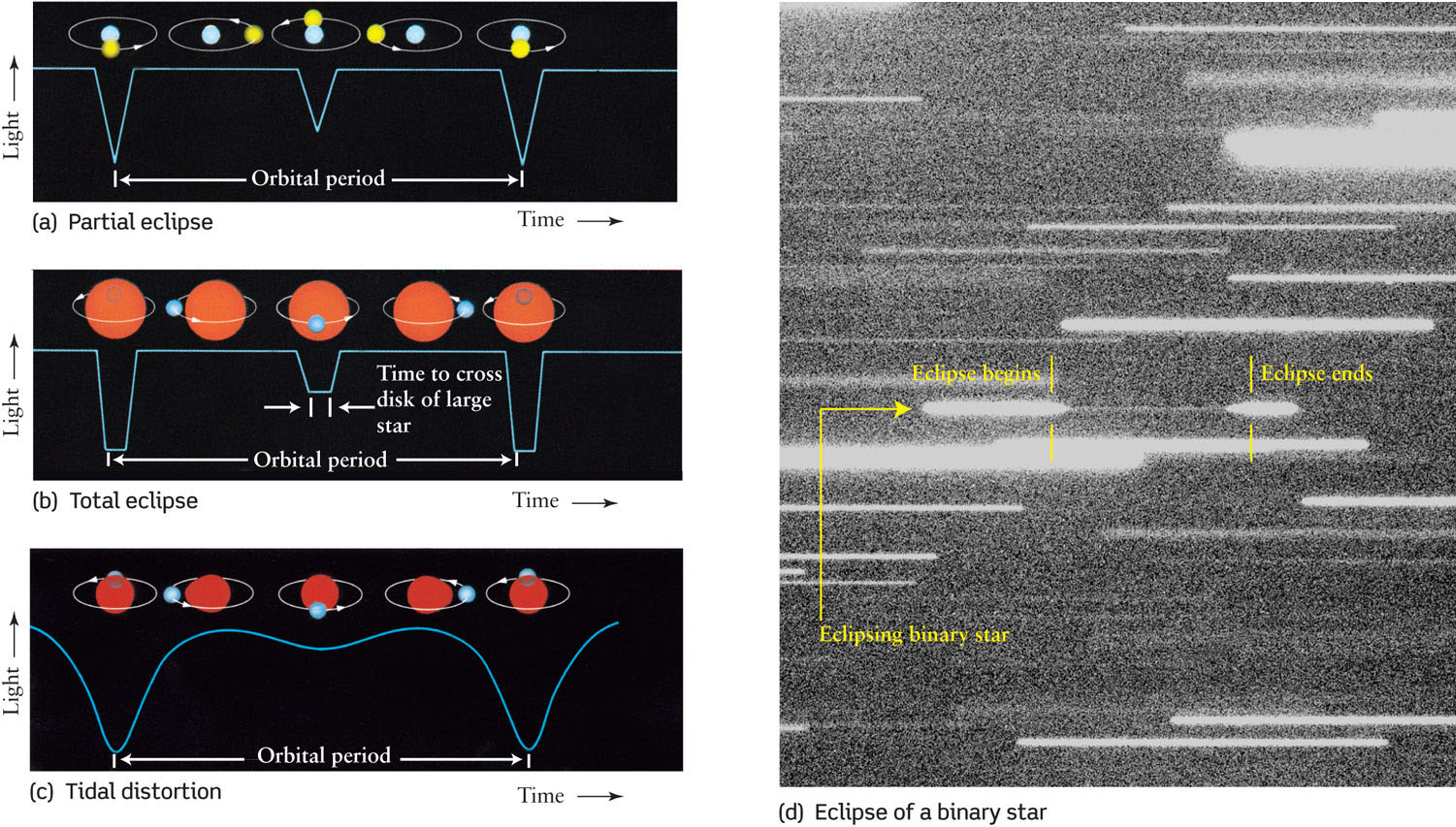17-11 Light curves of eclipsing binaries provide detailed information about the two stars
Some binary systems are oriented so that the two stars periodically eclipse each other as seen from Earth. These eclipsing binaries can be detected even when the two stars cannot be resolved visually as two distinct images in the telescope. The apparent brightness of the image of the binary dims briefly each time one star blocks the light from the other.
Using a sensitive detector at the focus of a telescope, an astronomer can measure the incoming light intensity quite accurately and create a light curve (Figure 17-24). The shape of the light curve for an eclipsing binary reveals at a glance whether the eclipse is partial or total (compare Figure 17-24a and Figure 17-24b). Figure 17-24d shows an observation of a binary system undergoing a total eclipse.

Representative Light Curves of Eclipsing Binaries (a), (b), (c) The shape of the light curve of an eclipsing binary can reveal many details about the two stars that make up the binary. (d) This image shows the binary star NN Serpens (indicated by the arrow) undergoing a total eclipse. The telescope was moved during the exposure so that the sky drifted slowly from left to right across the field of view. During the 10.5-minute duration of the eclipse, the dimmer star of the binary system (an M6 main-sequence star) passed in front of the other, more luminous star (a white dwarf). The binary became so dim that it almost disappeared.
Eclipsing binaries can reveal the sizes and shapes of stars
In fact, the light curve of an eclipsing binary can yield a surprising amount of information. For example, the ratio of the surface temperatures can be determined from how much their combined light is diminished when the stars eclipse each other. Also, the duration of a mutual eclipse tells astronomers about the relative sizes of the stars and their orbits.
If the eclipsing binary is also a double-line spectroscopic binary, an astronomer can calculate the mass and radius of each star from the light curves and the velocity curves. Unfortunately, very few binary stars are of this ideal type. Stellar radii determined in this way agree well with the values found using the Stefan-Boltzmann law, as described in Section 17-6.
The shape of a light curve can reveal many additional details about a binary system. In some binaries, for example, the gravitational pull of one star distorts the other, much as the Moon distorts Earth’s oceans in producing tides (see Figure 4-26). Figure 17-24c shows how such tidal distortion gives the light curve a different shape than in Figure 17-24b.
Information about stellar atmospheres can also be derived from light curves. Suppose that one star of a binary is a luminous main-sequence star and the other is a bloated red giant. By observing exactly how the light from the bright main-sequence star is gradually cut off as it moves behind the edge of the red giant during the beginning of an eclipse, astronomers can infer the pressure and density in the upper atmosphere of the red giant.
Binary systems are tremendously important because they enable astronomers to measure stellar masses as well as other key properties of stars. In the next several chapters, we will use this information to help us piece together the story of stellar evolution—how stars are born, evolve, and eventually die.
CONCEPT CHECK 17-21
Consider the total eclipse in Figure 17-24d. Why is there still a thin line of light during the total eclipse?
When the bright white dwarf passes behind the larger and dimmer star, the light coming from the dimmer star is still visible.